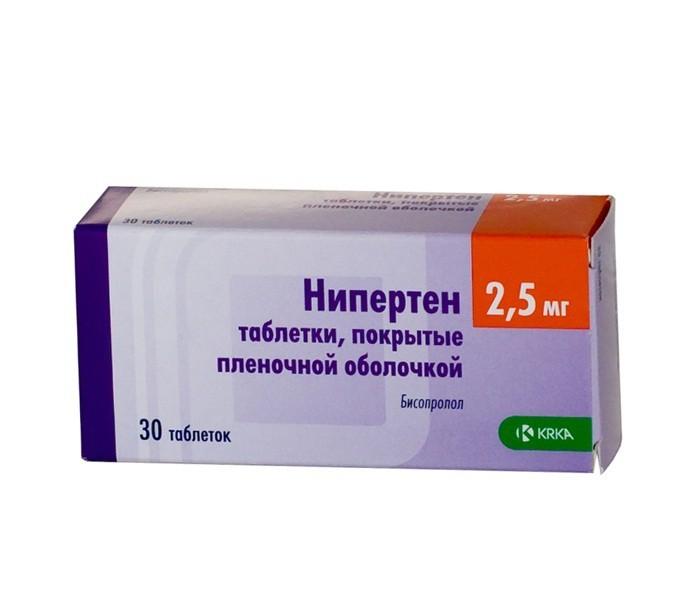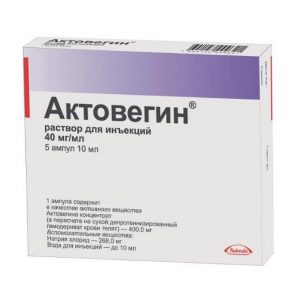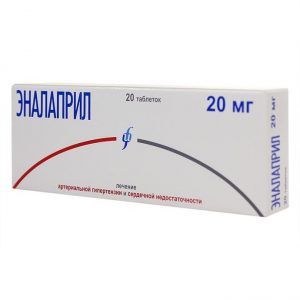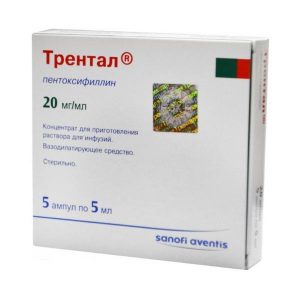Description
Release form
Film-coated tablets.
Packing
30 pcs.
Pharmacological action
NIPERTEN – selective beta1-blocker, without its own sympathomimetic activity, does not have a membrane-stabilizing effect. Reduces blood plasma renin activity, reduces myocardial oxygen demand, reduces heart rate (at rest and during exercise). It has hypotensive effect, antiarrhythmic and antianginal action. Blocking at low doses the 1-adrenergic receptors of the heart, reduces the formation of cAMP stimulated by catecholamines from ATP, reduces the intracellular current of calcium ions, has a negative chrono-, dromo-, batmo- and inotropic effect, reduces AV conductivity and excitability.
When the therapeutic dose is exceeded, it has a beta2-blocking effect.
At the beginning of the use of the drug in the first 24 hours, OPSS increases (as a result of a reciprocal increase in the activity of -adrenoreceptors and the elimination of stimulation of 2-adrenoreceptors), after 1-3 days it returns to its original level, and decreases with prolonged use. The antihypertensive effect is associated with a decrease in minute blood volume, sympathetic stimulation of peripheral vessels, restoration of sensitivity in response to a decrease in blood pressure and effects on the central nervous system. With arterial hypertension, the therapeutic effect occurs after 2-5 days, a stable effect is observed after 1-2 months.
The antianginal effect is due to a decrease in myocardial oxygen demand as a result of a decrease in heart rate and a decrease in myocardial contractility, lengthening of diastole, and improvement of myocardial perfusion. By increasing the final diastolic pressure in the left ventricle and increasing the stretching of the muscle fibers of the ventricles, oxygen demand may increase, especially in patients with chronic heart failure.
Antiarrhythmic effect due to the elimination of arrhythmogenic factors (tachycardia, increased activity of the sympathetic nervous system, increased content of cAMP, arterial hypertension), a decrease in the rate of spontaneous excitation of sinus and ectopic pacemakers and a slowdown in AV conduction (mainly in the antegrade and, to a lesser extent, in the retrograde direction through the AV node) and along additional routes.
When used in medium therapeutic doses, unlike non-selective beta-blockers, it has a less pronounced effect on organs containing 2-adrenergic receptors (pancreas, skeletal muscle, smooth muscles of the peripheral arteries, bronchi and uterus), and does not affect carbohydrate metabolism causes a delay of sodium ions in the body, the severity of the atherogenic effect does not differ from the action of propranolol.
Indications
– arterial hypertension
– IHD: prevention of angina attacks
– chronic heart failure.
Contraindications
– shock (including cardiogenic)
– collapse
– pulmonary edema
– acute heart failure
– chronic heart failure in the stage of decompensation
– AV-block sard IIp and grade III
– severe bradycardia
– Prinzmetal angina
– cardiomegaly (without signs of heart failure)
– arterial hypotension (systolic blood pressure less than 100 mm Hg, especially with myocardial infarction)
– severe forms of bronchial asthma and COPD in the anamnesis of
– simultaneous administration of MAO inhibitors (except for type B MAO)
– late stages of peripheral circulatory disorders
– Raynaud’s disease
– pheochromocytoma alphora (without simultaneous use)
– metabolic acidosis
– age up to 18 years (efficacy and safety have not been established)
– hypersensitivity to the components of the drug
– hypersensitivity to other beta-blockers .
With caution, the drug should be used in case of liver failure, chronic renal failure, myasthenia gravis, thyrotoxicosis, diabetes mellitus, AV blockade of the first degree, depression (including history), psoriasis, allergic reactions (history), in elderly patients.
Special instructions
Influence on the ability to drive vehicles and control machinery:
The question of the possibility of engaging in potentially dangerous activities that require increased attention and speed of psychomotor reactions should be decided only after assessing the patient’s individual reaction to the drug (especially at the beginning of treatment, in connection with the possibility of developing dizziness).
Composition
Active ingredients: bisoprolol fumarate (2: 1) 2.5 mg.
Excipients: microcrystalline cellulose, sodium carboxymethyl starch, povidone, anhydrous colloidal silicon dioxide, magnesium stearate.
The composition of the film membrane: hypromellose, macrogol, titanium dioxide, talc.
Dosage and administration
The drug is taken orally, in the morning on an empty stomach, without chewing, once.
Arterial hypertension and coronary heart disease: prevention of angina attacks
The recommended dose is 5 mg 1 time / day. If necessary, increase the dose to 10 mg 1 time / day. The maximum daily dose is 20 mg.
In patients with impaired renal function with CC less than 20 ml / min, or with severe impaired liver function, the maximum daily dose is 10 mg.
Dose adjustment in elderly patients is not required.
Chronic heart failure
The start of treatment for chronic heart failure with Niperten requires a special dose selection period. The prerequisites for initiating therapy are as follows:
– chronic heart failure without signs of exacerbation in the previous 6 weeks
– almost unchanged basic therapy in the previous 2 weeks
– treatment with optimal doses of ACE inhibitors (and vasodilators, in case of intolerance to ACE inhibitors), diuretics and, if necessary, cardiac glycosides.
Treatment is prescribed in accordance with the specified dose selection scheme. An individual patient response to the prescribed therapy is possible, i.e. the dose can be increased only if the previous dose is well tolerated. 1 week 1.25 mg 1/2 tablet 2.5 mg 1 time / day.
2 weeks 2.5 mg 1 time / day.
3 weeks 3.75 mg 1 time / day.
4-7 week 5 mg 1 time / day.
8-11 week 7.5 mg 1 time / day.
12 weeks and then 10 mg 1 time / day. as maintenance therapy
The maximum recommended dose of Niperten is 10 mg 1 time / day. After starting treatment with the drug at a dose of 1.25 mg (1/2 tablet 2.5 mg), the patient should be observed for about 4 hours (control of heart rate, blood pressure, conduction disturbances on the ECG, symptoms of worsening chronic heart failure).
During the dose selection period or after it, a temporary deterioration in the course of chronic heart failure, fluid retention, arterial hypotension, or bradycardia may occur. In this case, it is recommended, first of all, to pay attention to the selection of the dose of concomitant basic therapy (to optimize the dose of the diuretic and / or ACE inhibitor), before lowering the dose of the Niperten drug. Treatment with the drug should be interrupted only if absolutely necessary.
After stabilization of the patient’s condition, titration should be repeated or treatment should be continued.
Side effects of
From the central nervous system and peripheral nervous system: increased fatigue, weakness, dizziness, headache, sleep disorders, depression, anxiety, confusion or short-term memory loss, hallucinations, asthenia, myasthenia gravis, paresthesia in the extremities (in patients with intermittent claudication and Raynaud’s syndrome), tremor, convulsions.
From the side of the organ of vision: visual impairment, decreased secretion of lacrimal fluid, dryness and soreness of the eyes, conjunctivitis.
From the cardiovascular system: sinus bradycardia, palpitations, impaired myocardial conduction, AV block (up to the development of complete transverse blockade and cardiac arrest), arrhythmias, weakening of myocardial contractility, development (aggravation) of chronic heart failure (swelling of the ankles, feet, dyspnea), decreased blood pressure, orthostatic hypotension, manifestation of angiospasm (increased peripheral circulation disturbance, cooling of the lower extremities, Raynaud’s syndrome), chest pain, withdrawal syndrome (increased angina attacks, increased blood pressure).
From the digestive system: dry oral mucosa, nausea, vomiting, abdominal pain, constipation or diarrhea, impaired liver function (dark urine, yellowness of the sclera or skin, cholestasis), increased ALT and ACT activity, increased bilirubin levels, changes taste.
From the respiratory system: nasal congestion, difficulty breathing when prescribed in high doses (loss of selectivity) and / or in predisposed patients – laryngo- and bronchospasm.
From the endocrine system: hyperglycemia (in patients with non-insulin-dependent diabetes mellitus), hypoglycemia (in patients receiving insulin), hypothyroid state.
Allergic reactions: pruritus, rash, urticaria.
Dermatological reactions: increased sweating, skin hyperemia, exanthema, psoriasis-like skin reactions, exacerbation of psoriasis symptoms, alopecia.
From the musculoskeletal system: cramps (including calf muscles), back pain, arthralgia.
From the reproductive system: weakening libido, decreased potency.
From the hemopoietic system: thrombocytopenia (unusual bleeding and hemorrhage), agranulocytosis, leukopenia.
Metabolism: increased triglycerides.
Drug Interactions
Allergens, used for immunotherapy or allergen extracts for skin tests increase the risk of severe systemic allergic reactions or anaphylaxis in patients receiving bisoprolol.
Iodine-containing radiopaque agents for iv administration increase the risk of anaphylactic reactions.
Phenytoin with iv administration, funds for inhalation anesthesia (hydrocarbon derivatives) increase the severity of the cardio-depressant effect of bisoprolol and the likelihood of a decrease in blood pressure.
Niperten changes the effectiveness of insulin and hypoglycemic agents for oral administration, masks the symptoms of developing hypoglycemia (tachycardia, increased blood pressure).
Bisoprolol reduces the clearance of lidocaine and xanthines (except theophylline) and increases their concentration in blood plasma, especially in patients with initially elevated clearance of theophylline under the influence of smoking.
Antihypertensive effect is weakened by NSAIDs (sodium ion retention and prostaglandin synthesis blockade by the kidneys), corticosteroids and estrogens (sodium ion retention).
Cardiac glycosides, methyldopa, reserpine and guanfacine, slow calcium channel blockers (verapamil, diltiazem), amiodarone and other antiarrhythmic drugs increase the risk of developing or worsening bradycardia, AV blockade, heart failure and heart failure.
Nifedipine can lead to a significant decrease in blood pressure.
Diuretics, clonidine, sympatholytics, hydralazine and other antihypertensive drugs can lead to an excessive decrease in blood pressure.
Extends the action of non-depolarizing muscle relaxants and increases the anticoagulant effect of coumarins.
Three and tetracyclic antidepressants, antipsychotics (antipsychotics), ethanol, sedative and hypnotic drugs increase central nervous system depression.
The simultaneous use with MAO inhibitors is not recommended, due to a significant increase in the hypotensive effect, the treatment interval between taking MAO inhibitors and bisoprolol should be at least 14 days.
Non-hydrogenated ergot alkaloids increase the risk of peripheral circulation disorders.
Ergotamine increases the risk of developing peripheral circulatory disorders sulfasalazine increases the concentration of bisoprolol in blood plasma rifampicin reduces.
Overdose
Symptoms: arrhythmia, ventricular extrasystole, marked bradycardia, AV blockade, severe BP, chronic heart failure, finger or palm cyanosis, difficulty breathing, bronchospasm, dizziness, fainting, convulsions.
Treatment: gastric lavage and adsorption. Symptomatic therapy: with developed AV blockade – in / in the introduction of 1-2 mg of atropine, epinephrine or temporary staging of the pacemaker with ventricular extrasystole – lidocaine (class IA drugs are not used) with a decrease in blood pressure – the patient should be in Trendelenburg position – in / in the introduction of plasma-replacement solutions, with inefficiency – the introduction of epinephrine, dopamine, dobutamine (to maintain chronotropic and inotropic action and eliminate marked BP) in heart failure – cardiac glycosides, diuretics, glucagon in convulsions – in / in diazepam with bronchospasm – beta 2-adreno-stimulators inhalation.
Storage Conditions
The product should be stored out of the reach of children at a temperature not exceeding 30 ° C.
Shelf life
2 years.
Deystvuyushtee substance
Bisoprolol
Terms and conditions
prescription
dosage form
tablets
Possible product names
NIPERTEN 0.0025 N30 TABLE P / O
Niperten 2.5mg No. 30
Niperten 2.5mg Tab. p / pl / rev X30 (R)
Niperten tab n / a 2.5mg x 30
Niperten tab n / a 2, 5mg N30
KRKA d.d. Novo mesto AO, Slovenia




